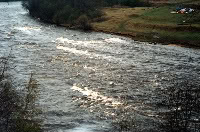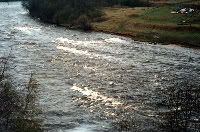Hydrokinetics and the DoE


I happened to be working on my book on renewables yesterday, and had the good fortune to knock out the chapter on hydrokinetics, which is based on a talk with Dr. Brian Polagye at the University of Washington. Brian is part of the DoE’s Northwest National Marine Energy Research Center for Tidal Energy; I was referred to him by an expert on the subject at the Electric Power Research Institute (EPRI) who told me, “In my opinion, Dr. Polagye is the nation’s leading researcher on hydrokinetic energy.” Good enough for me!
A few highlights:
I think – or I guess I should say I thought – of hydrokinetic energy as being essentially constant. The sun doesn’t shine 24 hours a day, but rivers never stop flowing. Yet there are significant variations in the extractable power from flowing rivers. As I suppose I should have surmised, rivers, based on rainfall as they are, experience significant seasonal variations. And tidal currents, of course, have periods of relative calm in cycles during the day. So there is nothing unique about hydro as a renewable source from this perspective.
As I noted in the white paper I wrote on the subject last summer, those wishing to submerge power generating devices in the rivers or oceans — in the US, at least — face a considerable battle in terms of regulation. As an advocate for renewables, that rankles me — yet Brian helped me put this in perspective. According to what he told me, the DoE is far more involved in expediting approval for such projects now than they were when the original devices were developed — but it’s still not easy – nor should it be. “If both sides aren’t screaming, regulators probably aren’t doing their job,” he said. “Environmentalists should probably be concerned that regulators aren’t sufficiently aggressive in protecting aquatic ecosystems, and entrepreneurs in power companies should be yelling that regulators are too sheltering and too slow to grant approvals.”
When I asked for an example to illustrate the point, Brian replied, “Easy. I’m up here in Puget Sound. If I have a turbine in the water and an orca washes up with its belly cut open – even if that was really caused by a ship’s propeller, it would set this operation back a decade – if it wouldn’t kill it completely.”
For my money, the real issue with hydro is scale. The theoretical limit to the amount of hydrokinetic energy that can be generated in our rivers, for instance, is the potential energy of the water in the first place, i.e., the weight of that water times the vertical distance it will fall. That is, by reports I’ve seen, insufficient to generate more that a few percent of North America’s power needs. “That may be true on a continental basis,” Dr. Polagye agrees. “But on a regional basis, hydro can make an extremely significant contribution.”
Fascinating stuff. My sincere thanks to Brian for his time, and for the dedication that he and so many others make to such a wonderful cause.
